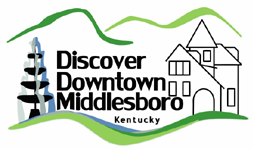Middlesboro, Kentucky, February 21, 2013 – Over sixty people
filled a packed room in the Alexander Arthur Museum for the Annual Meeting of
Discover Downtown Middlesboro last Thursday night.
President Keith Nagle
kicked off the festivities by welcoming the standing room only crowd, and
acknowledged special guests including Mayor Bill Kelley as well as several
members of City Council in attendance. Officials from the Bell County Chamber
of Commerce were also present and recognized.
 |
| Mayor Bill Kelley accepting an award for the Middlesboro Street Department from DDM Executive Director Isaac Kremer at the Annual Meeting. Photo credit: Frank Smith. |
Three Directors were
elected to new three-year terms by the membership. These included Jay Shoffner,
Donna Smith, and Penny Smith.
Secretary Carolyn O'Boyle
and Treasurer Philip Ball also acknowledged and welcomed guests. It was
reported that member contributions to DDM in the previous month have exceeded
all of member giving from the previous six years combined. This fact was
celebrated by applause from all of those in the audience.
DDM follows the
Four-Point Approach® to commercial district revitalization as established by
the National Trust for Historic Preservation. This approach calls for
grassroots citizen-led action in the areas of Organization, Promotion, Design,
and Economic Restructuring.
Organization
chair Donna Smith set the tone for the evening asking everyone in the room to
think of “one thing they can do to help the downtown.” She then stated her goal
to double the number of DDM members in the year to follow.
Other
committee chairs made their presentations too including Promotion Chair, Penny
Smith; Economic Restructuring Chair, Larry Grandey; and Design Chair, Jay
Shoffner.
Architect
James K. Piper, Jr. and Mr. Jon Rollins were both recognized. Their firm GRW,
Inc. is one of DDM’s newest members, and the two of them traveled all of the
way from Lexington to be present for the meeting.
DDM Executive Director
Isaac Kremer then addressed the crowd. He too welcomed those in attendance and
underscored the importance of the community coming together and how
"nights like this matter."
.jpg) |
| Historical photo of the Elks Home in Middlesboro. Photo credit: Middlesborough History website. |
Kremer began by stating
that DDM has acquired the 27,000 square foot Benevolent & Protective Order of
Elks Home (formerly the old hospital). The building was donated to DDM in December 2012
by lifelong Middlesboro resident Dallas Shackleford. James Madison, Executive
Director of the Bell County Historical Society was called forward and presented
DDM a check to assist with bringing in a structural engineer to help evaluate the
building. This news was greeted with great enthusiasm by the members and guests
in attendance.
Kremer reported that DDM expects
to be the recipient of a $10,000 grant to assist in the development of a
strategic plan for the downtown. A national expert will be brought in to
facilitate a weekend workshop in April or May. Dr. Jack McCann, Dean of the
Lincoln Memorial University Business School that is a partner in the project
spoke briefly about the strong bond between LMU and downtown Middlesboro.
 |
| View of the existing Canal Walk with recently installed Tour SEKY sign. Photo Credit: DDM, 2013. |
A vision to connect the
downtown and the Cumberland Gap National Historical Park via an upgraded and
expanded Canal Walk was also shared. This walk has the potential to promote
tourism, economic development, and to provide a valuable amenity for residents
and visitors alike. When the audience was asked to raise hands if they
supported the concept – the show of support was unanimous.
The meeting was closed by
sharing a new Mission Statement for DDM that goes as follows:
Discover Downtown Middlesboro, Inc. is a non-profit organization that encourages citizen participation in the revitalization of Cumberland Avenue between 10th and 24th Street and several mixed-use walkable blocks to the north and south. We seek to improve the physical appearance of the downtown while maintaining its historic integrity; to retain existing businesses and to attract new ones; and to make downtown Middlesboro the center of the economic, civic, and social life of the Tri-State area.
One final appeal was made
for those who are not members already to join. Everyone in attendance was also
encouraged to serve on at least one committee. A membership form as well as a
volunteer sign-up form are both available on the new Discover Downtown
Middlesboro website at: http://www.downtownmiddlesboro.org.
President Keith Nagle
adjourned the meeting around 7:45pm. Several of those in attendance opted to
stay for well over an hour afterwards to enjoy good company, tasty food, and
most importantly great conversation about the future of downtown Middlesboro.
Contact:
Isaac D. Kremer, Executive Director
Discover Downtown Middlesboro, Inc.
(606) 248-6155
###


